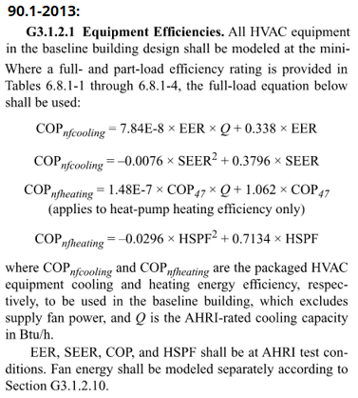Determining heating/cooling COPnf for 90.1
In case this isn't common knowledge, I'll provide an educational intro.. Rated heating/cooling efficiency values for packaged HVAC equipment (typically EER for cooling, COP at 47F for heating) includes the power input for the compressor, heat rejection/acquisition fan, supply fan, and essentially everything in the "package". In energy modeling, we model the supply fan separately from the heating/cooling components. Therefore, a calculation is required to determine the efficiency of the heating/cooling equipment without the supply fan. This is COPnf (subscript "nf") where "nf" = "no fan" and is used for both heating and cooling (or "nfheating", "nfcooling" if you prefer).
I've used different sources to obtain equations that can perform these adjustments during my career. In my eQUEST days, the wizard would even do the conversion for you, and the DOE2 user manual also provided equations that could be used. In California, the Title 24 NRACM used the same equations:
 Note that EIR is the inverse of COP.
Note that EIR is the inverse of COP.
I noticed that 90.1-2013 G3.1.2.1. added these equations directly, so I started using these:

However, in 90.1-2019, they removed these equations from the section. Instead, they added tables in Appendix G (not Chapter 6) where the user looks up COPnf values for the baseline model HVAC systems based on the system type and capacity range (oh, except for equipment with small capacities, but I digress). So apparently 90.1 doesn't care how you come up with COPnf values for your proposed design model.
So here are the questions:
- What are people doing to determine COPnf for heating/cooling equipment like packaged rooftop units, VRF systems, and mini-split heat pumps (including those less than 65 kBtu/h capacity)?
- How are you converting SEER2 and HSPF2 which is applicable to small equipment regulated under the federal appliance efficiency standards starting 1/1/2023?
Before you say, "just get it from the equipment manufacturer".. I can assure you that most off-the-shelf equipment does not have that level of documentation. If you think otherwise, please share how you're doing it with links/screenshots for a smaller heat pump or VRF system.





